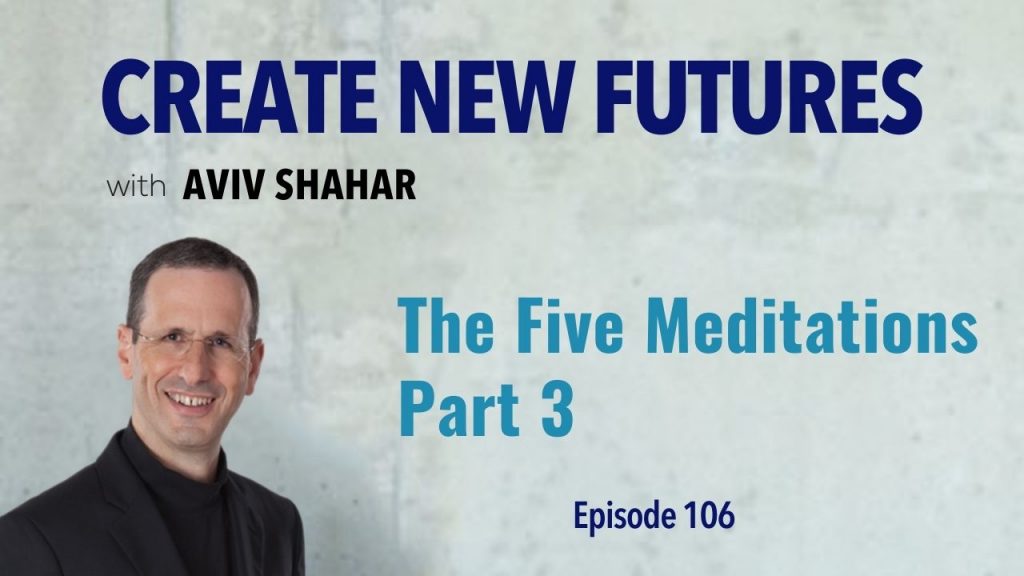Hello Leader,
In Part 1 and Part 2 of The Five Meditations, I described three meditation techniques. These practices, along with the additional two I focus on in this Key, help me thrive in the face of challenge and enable me to explore the edge of the human capacity to perceive and actualize possibilities and achieve remarkable results. Certain practices help me be more ready to respond to emergent situations (challenge and opportunity), while I use others to foster new creative possibilities and outcomes. Some meditations are intended to free the mind from the magnetic hold of thoughts, feelings and emotions and their own momentum. Other techniques are designed to focus the mind on an object of importance and probe to invite knowledge and intelligence.
My intent in this series is not to create a full step by step “how to” tutorial, as that task requires more than a newsletter. Instead, I am mapping the terrain at a high level. My hope is that you find inspiration into your discovery and development work.
The Five Meditations - Part 3

Listen here: Episode 106 - The Five Meditations – Part 3
Let’s briefly review the first three techniques before we delve into the other two meditations.
The practice of mindfulness is grounded in the awareness that I am not my thoughts or my feelings. I therefore have the capacity to observe thoughts and feelings as they arise, to release them rather than identify with them. Mindfulness expands my inner space, frees me from reactiveness, and therefore improves every aspect of my life.
The practice of interior printing is visualizing an inner state of how I intend to feel, so I can cause that state to happen in my body. Internal visualization enabled me to win long-distance running championships, accelerate healing, and catalyze courage, resilience, and vitality by meditatively 3D printing the desired state experience inside.
The practice of exterior printing includes a vast range of imagery techniques including consecrating special places as destinations for meditative pilgrimages to draw near, attune and connect to healing and creative powers. Exterior printing also is applied to set an ecology and design an experience for a specific endeavor or workshop, ensuring that the group taking a discovery journey has the energetic nutriments necessary to support its endeavor.
To conform and harmonize with your nature, these and other practices and modalities must be adapted to your situation and needs. In my case, I spent my entire adult life pursuing the frontiers of transformative possibilities. The central inquiry that guided my work with executive teams was how do you produce a high-functioning team capable of achieving breakthrough results?
To answer this question and enable the unique and differentiated results enjoyed by the clients we serve, I have used the techniques I describe here. While I rarely disclose to clients that there was more to our work than what meets the eye in the workshop, many of them have felt or intuited that our collaborative work was enhanced and supported by a focused inquiry and energized care and attention.
Let’s explore the fourth and fifth techniques I use. They enable me to stay grounded while I create my own peak experiences and those for the leadership teams I help.
4. Abiding prayer
The fourth technique includes a range of prayers and repetitions designed to facilitate an abiding concentration. A simple and popularized repetition is a mantra. Someone may give you a mantra or you can self-select a word or a phrase to meditate on or to speak softly or even to chant. Generating a singular note that you come back to again and again is a conditioning ritual that catalyzes a desired state of peaceful concentration.
For example, there are practices that can be found in most faith traditions and world religions that involve memorizing a sacred text and reciting it as a prayer to get on the frequency wavelength of the words and their meaning or intent.
Earlier on my journey, there was period when I used a series of affirmations daily as an intention-setting practice. Abiding with affirmation in repetition is a way to imbue every cell in your body with an intentional message. I spoke the affirmations at variety of speeds and intonations, sitting at rest or walking or dancing, all with the awareness that for the desired message to spread throughout my system, each part needs to receive it in its own speed and nature.
The validity of the self-inquiry, “Am I one with my intentions?” is that it takes time and practice to effectively reach with a clear determined intention every part of you, including the subconscious mind. An important awareness in the practice of repetition is to exercise compassionate self-care and avoid a judging or self-punishing preoccupation.
The affirmations and repetitions described here are forms of self-prayer. Of course, there are many other prayer forms, including a recited text, a reading of an invocation, and an emergent spontaneous petition. As I described in the interior printing technique, prayers can be said while restfully sitting or while engaging in activities such as walking, jogging, swimming and even dancing.
An abiding prayer has the power to create a sense of harmony and oneness, especially when it has found a way to imbue every cell and cause an inner glow and conductivity at the cellular level, which occurs when the full orchestra that is you plays a unified, harmonious note.
I have chosen to fashion my own abiding prayers, which have evolved through the years as my journey demanded. Prayer abiding practices are especially helpful when I am under considerable pressure due to my workload. I have found ways to combine them with the interior and exterior printing practices I described earlier. I find great comfort and reassurance in such techniques and the structures of thought they facilitate. Over time, these repetitive practices build a huge reservoir of power.
One caveat is that abiding prayers cannot be said on autopilot. To be vibrantly alive and not monotonously boring, these prayers require that I be present if I wish to find fresh angles, innovative ways, and a revitalized energy. A good place to begin your practice is to develop your own self-fashioned prayer and the power words that will anchor it, just as I have done for myself.
5. Contemplative inquiry
Of the many techniques I have practiced over the last 45 years, this fifth meditation has been most central to my work. There are many kinds of contemplative and inquiry practices that differ from the meditative techniques I described. Rather than catalyzing a particular state and/or experience, they are open-ended, probing for new intelligence, appreciation and insight.
Contemplative inquiries are powered by the extraordinary capacity of the mind to travel far beyond one’s physical location and to cast a very wide net.
Inquiry-based meditation is centered on a particular question that is held for a long period of time in a contemplative fashion. The exercise calls for the ongoing refinement of the inquiry’s formation so that it becomes increasingly precise. The refinement process is a way of engaging your own mind as well as connecting to the intelligence streams that are available for you.
I have practiced contemplative inquiry in a variety of situations, including while sitting relaxed with my eyes closed or open, while walking and hiking, and while writing. I have found writing to be a powerful form of continuous inquiry.
I have applied contemplative inquiries to a variety of needs and situations. These include a project I am developing with a team as well as inquiries about helping someone, resolving conflict, healing, and addressing puzzling theological and spiritual development conundrums. Throughout my journey, I have focused on inquires such as:
- What are my purpose and calling?
- Who and what can I serve best?
- How will I offer the highest service in this situation?
- What are my deepest aspirations?
- What qualities/virtues do I need to develop?
- What blind spots and shadow work must I attend to?
Here are some impersonal inquiries I have contemplated:
- What is the nature of the human spirit? Where does it come from and why?
- What “stop situations” create obstacles for people’s development? How can these be overcome individually and collectively?
- What fashions the journey to mastery?
- How does one become an active conduit for higher intelligence?
I’ve contemplated such inquiries for long periods of time, including writing about them every morning for several months.
A parallel application is lodging a compelling intention to resolve a spiritual, theological or esoteric mystery by contemplating it in the evening before going to sleep. I always have a pad next to my bed because at times I am awakened in the middle of the night by an answer. This technique directs the non-local capacity of the mind to cast a wide net, even during sleep, as the unconscious propagates these processes unceasingly.
As I studied the most original thinkers in the sciences and the arts who created important innovations and opened groundbreaking horizons of possibility, I discovered that they all used various forms of contemplative inquiry.
I end with two final thoughts to stimulate your contemplation. First, your higher faculties have many ways of communicating and imparting wisdom and knowledge. Contemplative inquiry is a way of engaging these processes to let them know you are interested and open to receiving what they are ready to deliver.
Second, what you feel and experience are shaped largely by what you focus on, which grows and magnifies with the presence of your attention. During the gratefulness practice, I focus on counting my blessings, appreciating what I am grateful for, and abiding with gratitude to the point where I recognize how blessed I am. Ours is a compassionate universe that surrounds each of us with so much assistance, support, love and care. Our application practice allows all these blessings to reach us.
Now it’s your turn. Turn the key. Discover the meditation practices that work best for you. By devoting this time to yourself, you invest in all that you love and care for. By developing the techniques of mindfulness, interior and exterior printing and prayers and by engaging in your contemplative inquiries, you will find many blessings and new doors of possibilities opening for you. Let me know if you would like my help in visualizing your own discovery and growth.
© Aviv Shahar

